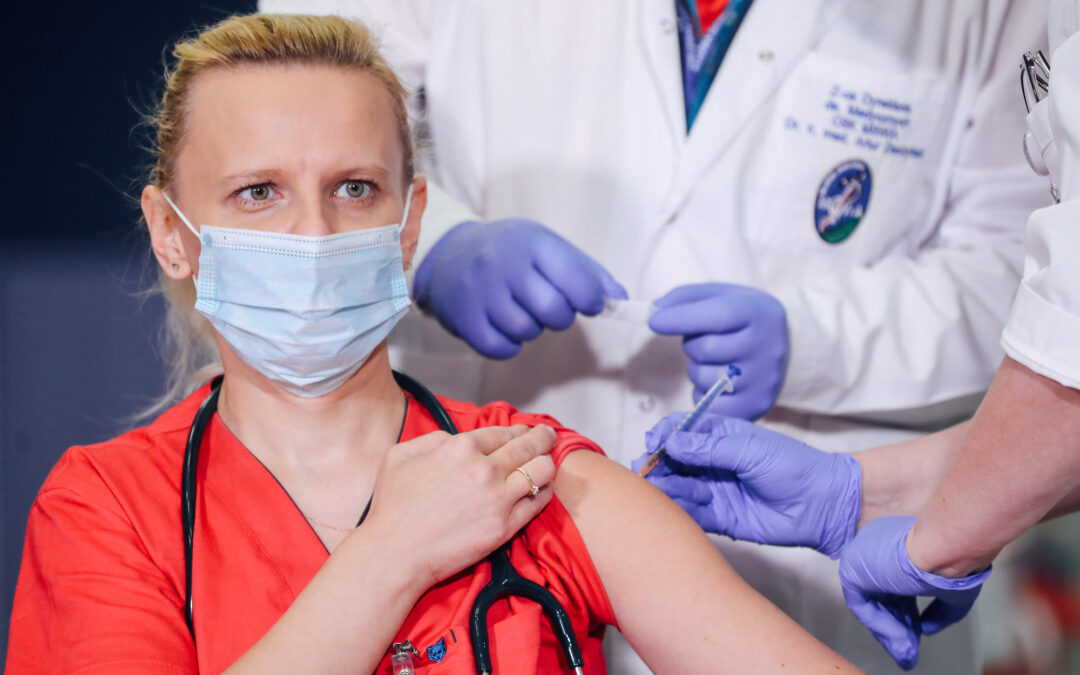By Marcin Waligóra
The national COVID-19 vaccination programme in Poland got underway on 27 December, when Alicja Jakubowska, a nurse at a Warsaw hospital, became the first person to receive the vaccine.
In a publication providing information about the programme, the health ministry declared that its “strategic aim is to achieve a level of vaccination of society making it possible to control the COVID-19 pandemic by the end of 2021, while also maintaining the highest safety standards”.
In Poland, discussions on the priority list of the groups to be vaccinated have been overshadowed by questions surrounding lack of trust in the new vaccines against COVID-19, produced in record time and granted conditional marketing authorisation by the European Medicines Agency.
Indeed, the level of willingness to get vaccinated has been particularly low among Poles. When the national vaccination programme commenced, according to a CBOS poll, only around 38% of Poles declared that they intended to vaccinate.
Trust in science
But Poland is far from unique in this respect. The scepticism of part of the population, known as “vaccine hesitancy”, resembles that observed in other countries: the nearer the registration of the first vaccines by the European Medicines Agency and the US Food and Drug Administration came, the fewer the numbers of people saying they would get the jab.
In fact, the moment of introduction of the vaccines seems to have been the peak of distrust. It seems likely – and is to be hoped – that this trend will now continue to gradually reverse, and the level of trust will increase as the number of vaccinated people rises. This seems to be confirmed by research from mid-January showing that the number of people declaring that they intend to get the vaccine had risen sharply, from 38% to 68%.
The Polish government is making efforts to battle the remaining scepticism, encouraging people to “trust science” and promising special privileges for those who have already been vaccinated. According to 3M State of Science Index research, the general level of trust in science in Poland has risen, as it has in other countries too. Trust in scientists in Poland during the pandemic has risen from 78% to 85%.
The likely reason for this is the fact that science has been on display in the media perhaps more than ever. Scientists have also been instrumental in numerous information campaigns associated with the battle against COVID-19.
The Polish Academy of Sciences, for example, established a COVID-19 task force publishing regular reports and statements. Good communication, transparency and an expectant public have strengthened the position of science in Poland and elsewhere.
Vaccination models
By setting out priorities of access to vaccination, the Polish programme has also mirrored solutions that are proving popular in other countries. Two models seem to be leading the way around the world: the first prioritises the most vulnerable groups, including the oldest age groups or those at greatest risk as a result of the potential course the illness can take and possible complications.
The second approach prioritises frontline essential workers, especially those working in the medical field. This is the distribution model that is being employed in Poland, although certain untypical elements set it apart from other countries.
The national vaccination programme in Poland introduced four stages of distribution of the vaccines (although there have also been some mixed messages and apparent changes of mind from the government): the so-called “zero group” included people working in the health protection sector, staff of social welfare centres, including auxiliary personnel, and also teachers and students of medical schools.
Phase 1 covers nursing home residents, people aged over 70 (increased from the originally planned 60), the uniformed services and teachers. Those to receive the vaccination in Phase 2 are people aged under 60 and with chronic illnesses, as well as those “ensuring the functioning of the fundamental activity of the state”. Phase 3 comprises “owners of businesses and employees in sectors closed by decrees” and the rest of society.
Perhaps the most controversial aspect of the plan has been the fact that the zero stage also included non-essential medical workers – something that differentiates the Polish system from similar solutions employed in other countries.
By way of comparison, the first group to receive the vaccine in Germany encompasses people aged over 80, care workers employed in nursing homes, healthcare workers with a high risk of exposure to COVID-19 and those primarily treating patients with a higher risk of dying from the disease.
And on the other side of the Atlantic, the Canadian government has put a very similar system in place. The first stage there covers residents and staff of communal living settings providing care for seniors, adults aged 70 and over, and healthcare workers, as well as adults in Indigenous communities, which are more susceptible to serious consequences from infection.
Queue-jumping controversy
Further controversy resulted from the allocation of vaccinations only days after the first ones were administered in Poland, with certain celebrities perceived to have jumped the queue.
A number of well-known actors and other personalities shared information on social media that they had already been given their first shot at the Warsaw Medical University (WUM) hospital. The story soon boiled over into a huge nationwide scandal on the front pages of the newspapers.
The health ministry ordered an investigation at this and other vaccination centres, as it emerged that 18 famous people who were supposed to become “vaccine ambassadors” had received jabs at WUM.
The clinic explained that it had found itself needing to distribute an excess supply of 450 vaccines in a short time before they expired. The scandal may in fact have had an unexpected effect of contributing to the rising interest in getting a vaccination among Poles.
Rolling out the vaccines
Compared to other European Union countries, the COVID-19 vaccination campaign in Poland has been quite effective. At the beginning of February, Poland was in fourth place among the 27 EU countries in terms of the numbers of doses administered. Like other EU countries, it faces difficulties caused by delays in deliveries from the producers.
Poland’s vaccination strategy is based solely on deliveries negotiated with producers by the European Commission. At present, the most frequently administered vaccine is Comirnaty, produced by Pfizer/BioNTech at a rate of 350,000 doses a week. In the second half of January, the first doses of the Moderna vaccine arrived, and the AstraZeneca vaccine was authorised by the EMA at the end of January.
However, Poland has joined a number of other countries in deciding not to administer it to patients older than 65, claiming that there is not sufficient evidence of its effectiveness for this group. The near-total reliance on Pfizer supplies contributed to a slowdown in the vaccination rate in mid-January, as the company announced a temporary delay in production caused by expansion of its production line.
Unlike some other countries, including Germany, the Polish government is not ordering or purchasing additional doses, instead counting exclusively on the European Commission and the solidarity of European Union member states. At the same time, the government have avoided emphasising the leading role played by the EU in vaccination policy.
Nationalism and passports
The debate on fair access to COVID-19 vaccinations in Poland has so far been almost completely limited to the national context, and an attitude sometimes known as “vaccine nationalism” has prevailed.
Discussion has only taken into account Polish citizens and people living in Poland. There has been scant mention of provision of vaccines to developing countries, unfortunately, in the scope of international programmes such as COVAX, designed to ensure equal access to COVID-19 vaccinations throughout the world.
At the same time, the Polish government backed the idea of a vaccines passport, and was the first to introduce a rule whereby people with a vaccination certificate are allowed to enter the country without additional restrictions.
In fact, though, it may have been too hasty in this respect. The World Health Organisation has expressed scepticism over the introduction of such a passport, saying that there are still too many unknowns associated with reduction of transmission of the virus by people who have been vaccinated. It would also certainly contribute to an increase in existing inequalities, by further privileging citizens of developed countries.
Poland’s national vaccination programme faces numerous challenges in the months (and years?) ahead. At present, the most important one is to accelerate the whole process, if it is to come even close to achieving its objective. To date, a daily average of 45,647 doses have been administered throughout the country.
This rate has been increasing, and must continue to do so. The government claims that between 3.5 and 4 million doses can be administered monthly, as long as supplies are available. If it does not manage to step up the pace, then by summer 2021 just 26% of Poland’s total adult population will have been vaccinated – far short of the European Commission’s stated aim of 70%.
Translated by Ben Koschalka
Main image credit: Adam Guz/KPRM (under public domain)





















